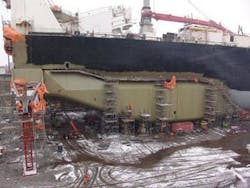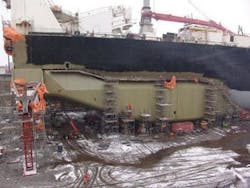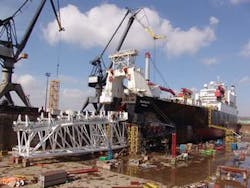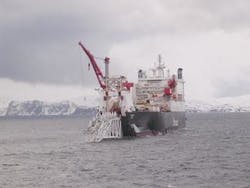Solitaire undergoes preparatory re-vamp as GoM developments head deeper
Jeremy Beckman; Editor, Europe
According to a paper Allseas delivered at OTC last month, S-lay dominates deepwater pipelaying in the Gulf of Mexico. Measured by length, S-lay accounts for more than 75% of all the pipelines in over 3,000-ft of water. The challenge now will be to adapt S-lay to future projects in much deeper locations.
S-lay entails the use of heavy tension equipment and a long stinger. To employ the tensioning system effectively, and to limit bottom tension, the pipe’s departure angle on exiting the stinger should be near-vertical. Only a long stinger can provide adequate guidance to convey large-diameter pipes from the horizontal to near-vertical position. This is because the requirements for over-bend strains in pipelines dictate use of relatively large stinger radii for large-diameter pipes.
With several such installations in prospect and contracted in water depths to 9,000 ft, Allseas decided last year to give its flagship S-lay vesselSolitaire a makeover. Following fast-track design studies last year performed in house and by Gusto Engineering, the vessel arrived in Rotterdam late this winter for a two-month program of structural and equipment upgrades. Keppel Verolme handled the main features of the work. De Boer Dintelmond rebuilt the stinger to form a new system, which is 460 ft long and capable of handling catenary pipelines weighing up to 1,000 tonnes. The ongoing program includes improvements to the vessel’s tensioning and abandonment and recovery (A&R) winch capacities to handle this type of tonnage.
Structural analysis
Solitaire has been in service since July 1998. Allseas had the vessel, originally a bulk carrier, converted at Sembawang Shipyard in Singapore and at the Swan Hunter yard in northeast England the previous year. “At that point,” says Allseas Innovations Manager André Steenhuis, “we were more focused on long export lines in mid-depth waters, such as Europipe.” In fact, North Sea trunkline activity was entering a quiet phase, leaving Solitaire freer to pursue opportunities in the emerging deepwater sector out west.
After six years of solid service - mainly in the GoM and northwest Europe, but with occasional assignments off Iran and The Philippines - Allseas began considering further modifications to the vessel early in 2004. The market was heading ever deeper, Steenhuis explains, so the upgrades Allseas planned were intended to satisfy requirements for at least the next five years.
“We knew that for upcoming projects in the GoM and the Norwegian Sea, we would have to lengthen the stinger and increase the vessel’s pipe tensioning capacity,” Steenhuis says. “But the big question was, what did we need in terms of extra tonnage and capacity?”
Allseas planned to lengthen the stinger from 360 to 460 ft, and to increase its pipe-carrying capacity from 525 to 1,000 tonnes. Initial thinking involved retaining the three existing sections of the stinger and placing an extra section (No. 4) in between. But there were concerns that the first section would not support the extra weight of the extended structure. Allseas decided to replace the existing Section 1 with two new stinger sections. As the revised stinger would have more weight, a higher capacity, and a longer length, the pipelay company also developed a new cantilevered stinger support with a recovery uplift protection system (peak shaver). Allseas would ensure vessel stability by adding 5,000 tonnes of extra buoyancy to the aft, with a weight of 1,400 tonnes of steel to provide improved resistance to potential bending moments.
To limit strain concentration on the rollers, the pipelay company would equip the new stinger with more roller supports than before. “To aid this process, we reduced the distance between the roller boxes from 11 to 8.5 m,” Steenhuis says. In addition, it introduced equalizers to achieve a more smoothly distributed strain level.
With the stinger capable of taking more tension load, it was possible to upgrade the tensioning system. Allseas commissioned SAS Gouda to design and install a 1,050-tonne tensioning system, which, according to SAS’ Raymond Kerkvliet, will be the largest ever built. The system comprises three 350-tonne, two-track pipe tensioners, designed to support installation of pipelines up to 60 in. with coatings ranging from rough concrete to smooth polypropylene.
“Other challenging aspects of our design,” Kerkvliet adds, “were the location of the tensioning system in the overbend point of the pipe and the need for it to fit within the space constraints ofSolitaire’s existing 525-tonne tensioner system. In view of the high load capacity, and the smooth surface provided by polypropylene coatings, it is crucial to be able to get a grip on the pipe and keep hold of it. For this purpose, we have applied a special shoe design, comprising a high-friction material with an enhanced contact surface, which will also allow for simple and fast change-out of shoes when required.” The latter situation could arise when the vessel has to switch to different diameter pipe installations.
SAS Gouda will install the new tensioning system later this year, afterSolitaire has completed its scheduled jobs this season.
Extended reach
Another concern for Allseas was how to upgrade the vessel’s A&R winch capacity from 420 to 1,000 tonnes and at the same time, address cabling constraints associated with winch operations in ultra-deepwater. The engineering team calculated that 5,000 m of steel cabling would be needed, but the maximum diameter of available cable - 6.5-in. - would only be able to withstand safe working loads of 650 tonnes during winching.
“One solution could have been to try fiber ropes, but winches are at present not ready for these kind of ropes,” Steenhuis explains. “So we decided instead to expand the number of winches.”
Allseas is retainingSolitaire’s existing 420-tonne A&R winch, stationed in the bow. Imeca in France is supplying eight winches. These comprise four new traction winches, providing a total dynamic pull capacity of 1,000 tonnes, and four storage winches capable of storing 5,000 m of cable length each. “We had wanted to place them in the aft section, but our naval architect advised us that the extra weight in this area would not benefit the high bending moment.” Instead, Allsea put the new winches on a newly built tweendeck in one of the holds, which had been used hitherto for pipe storage. It will place the four sets of winches on either side of the firing line.
Although the pipelay company had solved the problem of the total cable length, the introduction of four separate winch cables potentially raised the specter of increased twisting and kinking during deployment. To address these concerns, Allseas commissioned extensive tests and simulations, conducted both in house and by numerous specialist contractors in The Netherlands, using software such as Matlab and Adams. Allseas assigned Reading University in the UK, well known for its work on wire analysis, to handle practical tests.
“In fact,” Steenhuis says, “the analysis showed that the problem was not so great.” In addition, the company will install a cable control system for the winching operations, designed jointly by Allseas and Rexroth Hydraudyne.
Once Allseas completed the first phase of the refit/upgrade in April,Solitaire traveled to a fjord in western Norway for tests on the stinger, tensioners, and dynamic positioning system ahead of its first job this season on Statoil’s Snøhvit development in the Barents Sea. On Snøhvit the vessel has been installing a flowline between the field and the LNG processing plant on Melkøya Island. Spring comes late at this northerly latitude; however, according to Steenhuis, the laying operation went smoothly, despite gusts of wind of up to 50 kt. Special tools were on hand to keep the sheaves free of ice, but Allseas did not deploy them.
“We were all amazed at theSolitaire’s sailing speed and at how quickly it moved to high laying speeds once on location,” Steenhuis says. “This project involved laying heavy-walled pipe at rates of 3 to 4.5 km/day. Also, the vessel’s motions proved to be even better than what we had calculated.”
After Snøhvit,Solitaire headed south to the Norwegian Sea to lay the first 33 km of the Langeled line taking gas from Ormen Lange to Easington, UK. This fall, the vessel will return to port for the next phase of upgrades, which will include installation of a 2,000-tonne cantilever to support the last three sections of the stinger.
In winter 2005/2006,Solitaire will install a 24-in. line for Enterprise on the Independence Trail project in the GoM depths to 8,100 ft.
For future ultra-deepwater operations, the cantilever structure will also allow deployment of an arrangement known as ‘S-lift’, enabling installation of pipelines with an operational holding capacity of 1,500 tonnes and a contingency capacity of 2,000 tonnes. The basic idea is to limit the load on the stinger, tensioner, and A&R winch equipment via a system of two submerged clamps, both of which take the load of the pipe below the stinger. These clamps hang from the cantilever structure, which is on top of the cross-over extending 200 ft aft of the vessel’s stern.
The system can be applied not just for pipelay duty, but to provide contingency measures in the event of buckling or pipeline flooding. For contingency holding, only one clamp would be deployed, slipping passively over the pipe as laying is in progress. The clamp would only be activated in an emergency situation, such as sudden build-up of excessive tension caused by flooding of the line. The clamp would then lower the pipeline safely to the seabed for de-watering.
In “S-lift” mode, the axial pipe strain should be reduced to a very low value, allowing most of the pipe’s strain capacity to be used for global bending.




